Don’t think you can’t learn to lace wire wheels. While today many builders turn to a specialist like Buchanan’s Spoke & Rim for convenience, not so many decades ago wheel building was a part of every motorcycle mechanic’s skill set.
Wire wheels, so perfectly geometric, are attractive, artistic objects, easy to admire. They go together only one way, so in that sense they are like picture puzzles. Faced with a pile of spokes, a hub, and a rim, despair not. Just go find an assembled wheel of the same type and copy it. Puzzle fanatics first find all the edge pieces. With spokes, you begin by grouping them into outers (inner ends are more bent) and inners (inner ends are less bent). With the hub flat on a table, you put spokes through holes, and by copying an assembled wheel or your sketch of one, you gradually get the angles and crossings right. All ace wheel builders began with zero knowledge but with determination to plow on through error to success.
Next: the rim. Each of the rim’s spoke dimples is drilled off-center, indicating the direction from which its spoke should come. By looking and thinking, the implied plan will begin to make sense to you. Will you tape spokes together at their crossings to make handling the mess easier? Gradually, with mistakes and corrections, you get spokes into holes and spoke nipples and washers started on the spoke threads. All this is the “puzzle part” of wheel building. Next comes truing.
Ignore the chaos and concentrate on ideas. Three kinds of misalignments are possible. In a finished wheel, the rim will be properly centered over the hub flanges, not offset to one side (there are exceptions to this, but let's begin with a symmetrical wheel—the simplest case). The rim will be concentric, in that when you rotate the wheel, the rim does not pump up and down. The rim will be perpendicular to the axle—it does not wobble from side to side as it turns. Achieving these conditions is in your power. Some people true wheels with nothing but a pointer, but others use a dial gauge. Think of what the errors mean, and work out which groups of spokes you must loosen or tighten to correct each kind of error. That thinking is the key.
Rims themselves are not perfect, so some waviness will remain, especially at the weld. You will learn to ignore it. Strike the spokes with a wrench to gauge tightness, and adjust to get equal tone from all. Which tone? Ring the spokes in an existing similar wheel, and copy. Bask cautiously in your accumulating experience.
/cloudfront-us-east-1.images.arcpublishing.com/octane/YWV3YY3TID25DD6B57USXKJUVM.jpg)
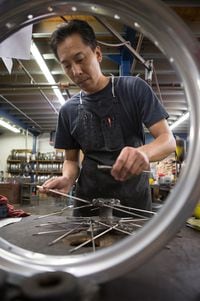
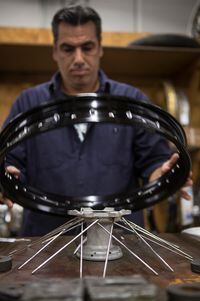
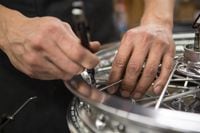
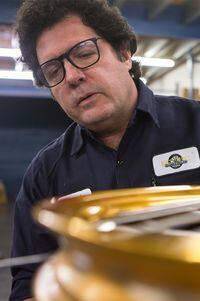
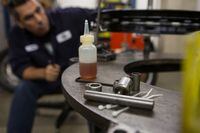
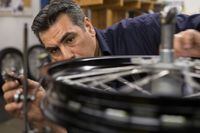
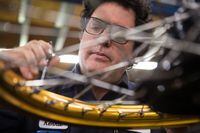
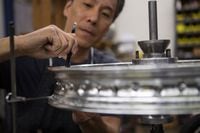
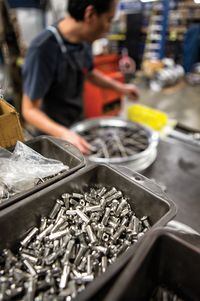
/cloudfront-us-east-1.images.arcpublishing.com/octane/IQD22T7WYGRRQMKFP5HMH74XDE.jpg)
/cloudfront-us-east-1.images.arcpublishing.com/octane/6CP6VKBMDRHPNLH4JFYVW6DMCM.jpg)
/cloudfront-us-east-1.images.arcpublishing.com/octane/4FYW5AN7YVFZBMWPAZ6COUXJJ4.jpg)
/cloudfront-us-east-1.images.arcpublishing.com/octane/VUOTFUMRZBFILJ4TBSKYNRPZDM.jpg)
/cloudfront-us-east-1.images.arcpublishing.com/octane/A2TMJNBKPBEQJEF6PB2Q5PGQHM.jpg)
/cloudfront-us-east-1.images.arcpublishing.com/octane/4YLIEQ7HGBH4FNXXYONJYS5K7U.jpg)
/cloudfront-us-east-1.images.arcpublishing.com/octane/5BDFMBN2KJE7JNJK7LJ7EG4A2M.jpg)
/cloudfront-us-east-1.images.arcpublishing.com/octane/C3WGBZCFABC7XKBCFCCXDWYWME.jpg)
/cloudfront-us-east-1.images.arcpublishing.com/octane/PLQ5M7MG3RG7BHYH2OILWJZIPY.jpg)
/cloudfront-us-east-1.images.arcpublishing.com/octane/CCPZFYVVRBF2DLPMDYKPF4TMME.jpg)
/cloudfront-us-east-1.images.arcpublishing.com/octane/SIAXQ2ZOPNBYBLPKJPCHIYGG6A.jpg)
/cloudfront-us-east-1.images.arcpublishing.com/octane/LRRTQXMMAFBVFOUYC2RI6ZBEAY.jpg)
/cloudfront-us-east-1.images.arcpublishing.com/octane/2NE3IENERFBTPDKVXPNTSMZZXE.jpg)
/cloudfront-us-east-1.images.arcpublishing.com/octane/7EG6FR6QOJGR7FFROLIPDUVTVM.jpg)
/cloudfront-us-east-1.images.arcpublishing.com/octane/QC73NNGYHZDWTNVTLNABEDJJ2Y.jpg)
/cloudfront-us-east-1.images.arcpublishing.com/octane/LMMTOYLL7BGE3FLR3OXDA4YQUI.jpg)
/cloudfront-us-east-1.images.arcpublishing.com/octane/EGXXXTWM2NABTOFTZBMZ2MWLUQ.jpg)
/cloudfront-us-east-1.images.arcpublishing.com/octane/EKKSANJIXNHQTNCANRHSTW7JHE.jpg)
/cloudfront-us-east-1.images.arcpublishing.com/octane/QSA4M5BQLFBAHIX33LEC63FH6M.jpg)
/cloudfront-us-east-1.images.arcpublishing.com/octane/OK3LWSOK3ZCMHJZZCEHOL2SRKQ.jpg)
/cloudfront-us-east-1.images.arcpublishing.com/octane/4E4BRX2RXVGNPCK4ODPMSUVBC4.jpg)
/cloudfront-us-east-1.images.arcpublishing.com/octane/SSLY6CGFJNDLVKSP5LBWZKVIHU.jpg)
/cloudfront-us-east-1.images.arcpublishing.com/octane/ENCTP2GIJ5DFVH2QPFJRFJ3IDI.jpg)
/cloudfront-us-east-1.images.arcpublishing.com/octane/P67HV34OANAFBDVK6U4FQ2M3YM.jpg)
/cloudfront-us-east-1.images.arcpublishing.com/octane/TG75U5MBR5FI3INUFFJEFMCOZI.jpg)